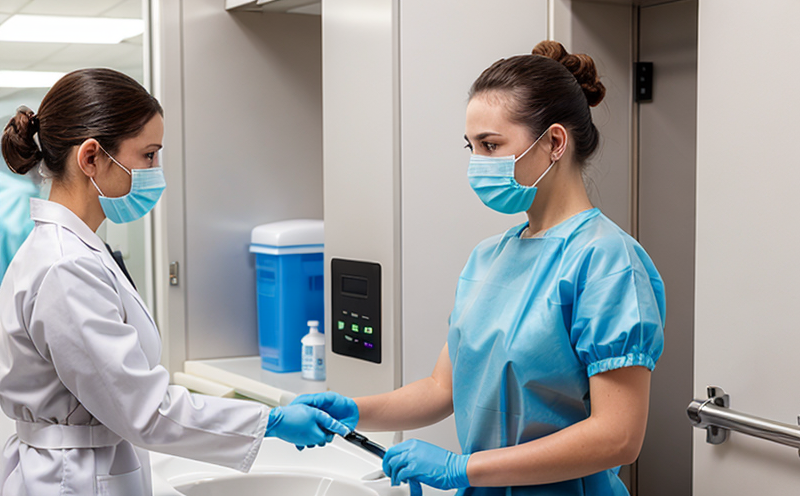Assessment of antimicrobial textiles used in footwear lining
The assessment of antimicrobial textiles used in footwear lining is a critical process that ensures the materials meet stringent hygiene and durability standards. This service focuses on evaluating how effectively these textiles inhibit microbial growth, ensuring they provide long-term protection against bacteria, fungi, and other pathogens. The importance of this testing cannot be overstated, especially in environments where prolonged contact with moisture or sweat can lead to the rapid proliferation of microorganisms.
Antimicrobial textiles are designed for use in various applications, including footwear linings, where they play a pivotal role in maintaining hygiene and preventing odor. This service involves a comprehensive approach that includes specimen preparation, exposure to controlled microbial environments, and detailed analysis using advanced laboratory instrumentation. The goal is to ensure the efficacy of these materials meets or exceeds industry standards.
The testing process begins with careful selection of representative samples from the footwear lining. These samples are then exposed to standardized microbial strains under defined conditions, simulating real-world scenarios such as high humidity and prolonged wear. Post-exposure analysis involves a range of microbiological techniques to quantify the reduction in microbial load on the textiles.
Advanced laboratory equipment plays a crucial role in this process. Instruments like scanning electron microscopes (SEM) and Fourier-transform infrared spectroscopy (FTIR) are used for detailed examination of the textile fibers, revealing structural changes that may indicate enhanced antimicrobial properties. Additionally, quantitative real-time PCR (qPCR) is employed to assess the presence and viability of microbial populations before and after exposure.
The results from these tests are meticulously analyzed and reported in accordance with relevant international standards such as ISO 20743:2016 and ASTM E2159. These standards provide a framework for consistent testing procedures, ensuring that the data is reliable and comparable across different laboratories. Compliance with these guidelines ensures that the results can be trusted by quality managers, compliance officers, R&D engineers, and procurement teams.
Understanding the real-world implications of this service is essential. In footwear manufacturing, maintaining hygiene in linings is crucial for both comfort and health. Consumers expect products that not only provide protection but also deliver a fresh, hygienic experience every time they wear them. This assessment ensures manufacturers meet these expectations by delivering textiles that can withstand repeated use without compromising on hygiene.
Moreover, the results of this testing are invaluable for product development. By identifying any shortcomings in the current antimicrobial performance, R&D engineers can refine their materials and processes to enhance effectiveness. For quality managers and compliance officers, the service provides a reliable means to verify that products meet regulatory requirements, thereby reducing the risk of recalls or legal issues.
Applied Standards
- ISO 20743:2016 - Hygiene Textiles for Consumer Use
- ASTM E2159 Standard Practice for Determining the Effectiveness of Antimicrobial Treatments on Textile Products
These standards provide a robust framework for testing antimicrobial textiles, ensuring that all tests are conducted in accordance with internationally recognized protocols. Compliance with these guidelines ensures consistency and reliability in the results.
Scope and Methodology
| Step | Description |
|---|---|
| 1 | Select representative samples of footwear lining textiles |
| 2 | Expose specimens to standardized microbial strains under controlled conditions |
| 3 | Analyze post-exposure samples using microbiological techniques like qPCR and FTIR |
| 4 | Evaluate structural changes in the textiles using SEM |
| 5 | Compare results with established benchmarks to determine effectiveness |
The methodology involves selecting representative samples of the footwear lining textiles, exposing them to controlled microbial environments, and then analyzing the post-exposure samples using advanced laboratory techniques. The comparison between pre- and post-treatment samples helps quantify the reduction in microbial load, providing a clear measure of the textile's antimicrobial efficacy.
Customer Impact and Satisfaction
Improved product quality: By ensuring that footwear linings meet high hygiene standards, this service enhances the overall quality of products for end-users.
Increased customer satisfaction: Consumers are more likely to purchase products that promise long-lasting hygienic benefits, leading to higher customer satisfaction and loyalty.
The impact extends beyond just the product itself. It also influences brand reputation and market positioning. Manufacturers who invest in this service can differentiate themselves by offering superior hygiene solutions, which is increasingly important in a competitive market.





